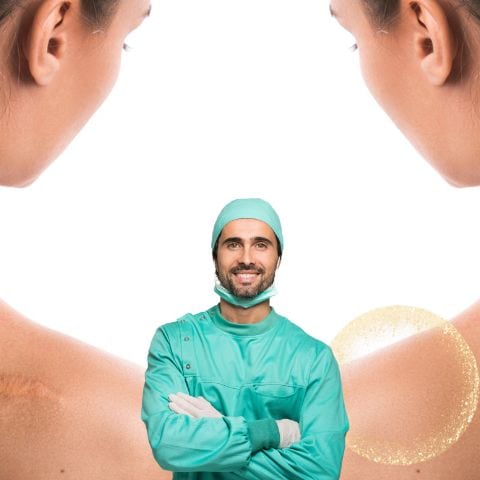Dealing with ugly scars can often lead to feelings of depression, as many people believe they are stuck with these reminders forever. However, they’re some good news for you. By the end of this article, you’ll discover that you can fade or reduce the scars tremendously.
To effectively remove different types of acne scars on the face, a combination of procedures and treatments is typically recommended. It is important to understand that there is no one-size-fits-all solution to the problem, as each individual’s skin varies in terms of texture and tone.
The key approach to addressing different types of acne scars is to combine different procedures that are specifically suited to the type of scars. By tailoring the treatment plan to the specific needs of the individual, you can achieve optimal results.

You have probably tried various methods and spent a lot of time researching how to deal with scars. I understand the frustration, which is why reading about my personal experience can offer you valuable insights. By sharing my journey, I hope to save you time and money, while also providing you with a road map towards achieving your goal of having more flawless skin.
If you’re someone who has struggled with a multitude of scars on your face, particularly from acne, I understand the frustration. Acne is an unwelcome part of life, and while we can’t prevent it entirely, we can improve the scars from it.
Sadly, there’s little information available on scars, and most surgeons you come across primarily focus on plastic surgery. I’ve been there and researched for many hours to find ways to address my scars, and although they’re not perfect, they have improved.
It’s disheartening to find generic online resources about scars that lack real personal experiences. It often feels like the authors haven’t personally dealt with scars and are simply rewriting the information they gathered from doctors or other online sources. But there’s more to it than just visiting a doctor and expecting flawless skin right after. I’ve learned the hard way that finding a good doctor is crucial since the wrong one can worsen your scars because not all doctors are created equal.
Through discussions with numerous surgeons and dermatologists, I’ve learned that scar treatment appears to be more difficult and complex than plastic surgery. Multiple surgeons have turned me down, concerned that the scars could potentially worsen or become larger.
I have gathered a list of methods I have personally tried to treat my scars. It’s important to remember that everyone’s skin is different, so it’s crucial to do your research and consult with a qualified professional who specializes in scar treatment. Each person is unique, and what worked for me may not yield the same results for you, especially if you have a different skin type or complexion.
1. Home Micro-Needling
At the top of the list is a procedure that has proven highly effective in removing scars, and the best part is it can be safely performed at home. However, it’s important to note that this home procedure carries some risks if not done correctly.
Before attempting it, make sure to thoroughly read all instructions to minimize the possibility of worsening your scars by applying excessive pressure or going too deep. It is recommended to repeat this procedure every two weeks and follow up by applying a scar cream to further improve the results.
The Banisher 2.0 is the micro-needling tool I use and highly recommend for at-home micro-needling. It is affordable and can be used up to 10 times before needing to purchase new needles. I have experienced the remarkable fading of one of my scars to the point where I have trouble finding it. That’s why it holds the top spot on my list and the risk is minimal.
You can expect the most improvements in areas that are firmer and less pliable. The forehead tends to yield the best results since it has a harder and firm surface. Additionally, the sides of the face, away from the cheek area and closer to the ear, also tend to show good improvements.
The cheek area might pose the most challenges and show the least response when using this method. This is because it tends to have a higher concentration of fat tissue and it also has more curves. When you apply pressure to your face, the presence of this fat makes it difficult for the needles to make an imprint and effectively scratch the surface of the face. Flatter areas also work better because you can press the needle straight down.
Remember, the key to improving your scars lies in creating small scratches on the surface. By doing so, you stimulate the growth of new skin that gradually replaces the old scars, leading to the scars fading over time. Overall I was very happy with the result and the cost was low as buying a new micro-needling pen every few months wasn’t bad at all in pricing.
Another benefit I’ve noticed from microneedling is its potential to help fade dark spots. As my skin renews and a fresher layer emerges, the dark spots seem to lighten up. I’ve noticed this positive change consistently through my at-home microneedling sessions. So if you’re looking to fade dark spots and sun damage then microneedling can also be useful.

2. Fractional CO2 Laser
This laser treatment holds the number two spot on my list due to its exceptional ability to tackle scars that are notoriously difficult to remove, especially on the nose. I had a few crater-like scars on my nose, and they posed quite a challenge to get rid of.
The nose is the most challenging part of the face to fix for scars as a few doctors turned me away and most of the other procedures I tried had no effect on it. However, after undergoing six laser sessions, I am thrilled to report that these scars have become barely visible.
While I could be content with the current results, I am considering a couple more sessions to potentially further improve the scars. The overall cost of this procedure, including the use of pricey face pads to address hyper-pigmentation if you have tanned skin amounted to approximately $500.
Finding a good doctor who is experienced in performing this procedure on your specific skin type is of utmost importance. In my case, as someone with Asian tan skin, it was crucial to ensure the compatibility of this treatment.
When searching for a surgeon, it is worth noting that relying solely on Yelp reviews can be misleading. It is advisable to thoroughly read both positive and negative reviews, paying particular attention to feedback related to scarring. This will help you ensure that the surgeon specializes in scar treatment.
Additionally, please keep in mind that this particular procedure may not yield optimal results for individuals with African skin, so consulting with a doctor beforehand is highly recommended.
The downside I discovered with this procedure is that it can be quite painful and you will most likely need numbing in the area being performed. Additionally, during the recovery process, you will need to avoid showing your face in public for about two weeks. This is because the scars will form crusts and gradually peel off, which may not be very appealing to look at.
Another important factor to consider is that this procedure can be among the more expensive options, depending on the depth of your scars. Achieving the desired results may require undergoing up to eight procedures or even more.

3. Subcision
Subcision is my choice for the number three spot because I experienced a significant improvement after my first subcision session. This procedure is highly effective for treating tethered scars that are depressed and held down by underlying scar tissue. Each session of subcision cost me around $500, and I underwent a total of five sessions.
However, I must mention that I had a negative experience with the doctor who performed my procedure. Unfortunately, he was too aggressive in treating my face, which resulted in a few scars worsening instead of improving.
That is why I always try to remind the people reading this article to find the best doctor they can afford as a bad doctor can make things worse not better. From my experience, a good doctor will never overcharge the patient because they care about the patient enough to give them a fair price.
The procedure itself is quick and you will immediately notice your scars popping up once it’s completed. However, it’s important to note that sometimes the scars can become depressed again after just a few days.
Overall the result was positive I saw noticeable improvements with this procedure. However, it’s worth mentioning that subcision has some limitations and is not suitable for treating pinhole scars. In some cases, this procedure may even worsen certain scars.
Nevertheless, if you have deep tethered scars, subcision may be one of the few treatments available. It’s important to recognize that combining different procedures is often the best approach, as no single procedure can address all types of scars.

4. TCA Cross
This procedure can be affordable and cost-effective if you can purchase TCA acid on platforms like Amazon and perform it yourself at home. I was able to save a significant amount of money by doing so. However, if you choose to visit a doctor, the cost may be around $400. Please note that these prices are specific to the San Francisco Bay area and are accurate as of 2023.
I would strongly recommend getting the TCA Cross procedure done at a doctor’s office or a reputable spa. Working with acid can be very dangerous, especially if you accidentally get it on your eyes. Incorrect application or lack of knowledge about proper aftercare can potentially worsen the scars. Therefore, it’s crucial to seek professional guidance to ensure safety and achieve optimal results.
TCA cross is one of the most effective procedures for treating pinhole scarring. If you have numerous small pinhole scars, this procedure can greatly seal them up slowly by making them more shallow and you help in addressing this concern.

In my personal experience, I found it effective to perform TCA cross every two months or longer, or as advised by your doctor. With each session, the pinhole scars gradually become shallower until they reach your desired research.
This approach allows for progressive improvement over time and has very little downtime. The little pinhole scars will scab after a few days and will fall off a week after the procedure. You can most likely still go out in public if the pinhole is small as people will have to get close to you to look to see it and it will appear like a little blackhead.
To optimize results, I recommend avoiding showering or washing your face for two days after performing the TCA cross procedure. This helps prevent the scabs from falling off prematurely, as keeping them on longer tends to yield better outcomes. Additionally, before going to bed, you can apply Mederma on your face to keep the scabs moist, further enhancing scar improvement.
TCA acid is also utilized as a skin peel when appropriately diluted, promoting the emergence of a newer, fresher skin layer. I observed that TCA Cross also helped fade dark spots on my face, revealing lighter, rejuvenated skin after one of my scabs naturally came off. However, it’s crucial to conduct further research or consult with your skin doctor, the professional administering these procedures, for additional clarification. You should always prioritize your skin health and seek professional advice when in doubt.
5. Differin Gel
This gel is highly effective in removing dead skin cells from the face and addressing issues like sun damage, light scarring, and other acne problems. While it is a valuable product, it is important to note that its impact is limited, a cream can only do so much.
Differin Creams and gels can help fade mild scars and are an affordable option. I highly recommend keeping some at home to assist with mild and surface-level scarring. Differin Gel is also my go-to treatment for dealing with breakout and it also helps with improving texture.

How Do You Get Rid of Stubborn Acne Scars on Your Face?
Based on my personal experience and the feedback I received from several surgeons, I want to highlight that scars located in the middle of the nose can be particularly challenging to fix. In my case, I had a wide and deep crater scar right near the middle of the nose, which made it one of the most difficult scars to deal with and extremely noticeable.
Interestingly, three out of four of the surgeons I consulted didn’t express much confidence in treating this specific type of scar. They emphasized that the skin on the nose doesn’t heal in the same way as the rest of the face, making it more complex to treat.

Why Are Acne Scars So Hard to Get Rid Of?
I’ve found that scars are generally difficult to eliminate. Interestingly, most plastic surgeons I consulted, who also specialize in scar revision and plastic surgery, seemed more confident in performing procedures to enhance a person’s overall appearance rather than focusing solely on scar treatment. Even my current doctor, whom I consider to be skilled in scar revision, has mentioned that the techniques for scar revision are not yet perfected and require time to achieve optimal results.
Conclusion
Hopefully, these tips prove helpful in your journey to treat your scars, as information on scarring can be scarce. From my discussions with surgeons and personal experiences, I’ve learned that scar treatments require time and patience, and they are not perfect.
It’s important to mix and match different procedures with the guidance of a skilled surgeon, as there is no one-size-fits-all. Each procedure may have varying effects and limitations, so careful experimentation is necessary to find what works best.
Additionally, conducting your research is crucial, as even a good surgeon may not have the time to provide all the necessary details for aftercare. Remember, it’s your face, and you’re the only person who should watch out for your skin and not leave it in the hands of another person.
By AL Tran
Source:
- Sand, M., Sand, D., Thrandorf, C., Paech, V., Altmeyer, P., & Bechara, F. G. (2010). Cutaneous lesions of the nose. Head & Face Medicine, 6, 7. https://doi.org/10.1186/1746-160X-6-7
- Iriarte, C., Awosika, O., Rengifo-Pardo, M., & Ehrlich, A. (2017). Review of applications of microneedling in dermatology. Clinical, Cosmetic and Investigational Dermatology, 10, 289-298. https://doi.org/10.2147/CCID.S142450
- Bhardwaj, D., & Khunger, N. (2010). An Assessment of the Efficacy and Safety of CROSS Technique with 100% TCA in the Management of Ice Pick Acne Scars. Journal of Cutaneous and Aesthetic Surgery, 3(2), 93-96. https://doi.org/10.4103/0974-2077.69020
- Loss, M. J., Leung, S., Chien, A., Kerrouche, N., Fischer, A. H., & Kang, S. (2018). Adapalene 0.3% Gel Shows Efficacy for the Treatment of Atrophic Acne Scars. Dermatology and Therapy, 8(2), 245-257. https://doi.org/10.1007/s13555-018-0231-8








